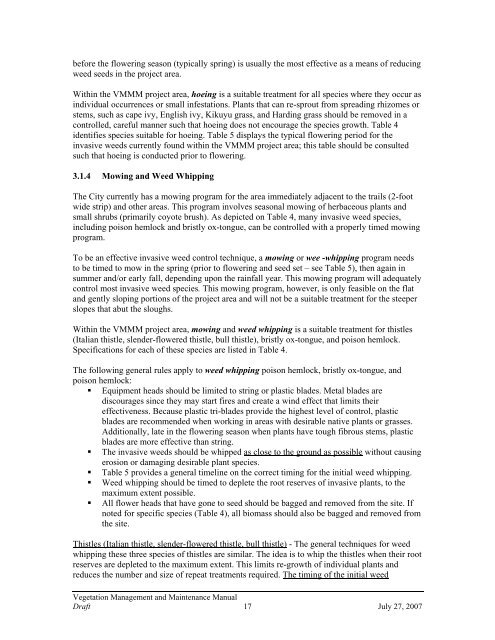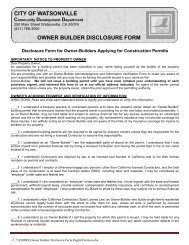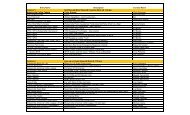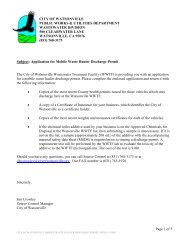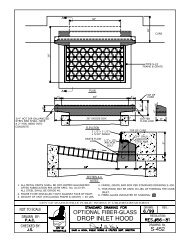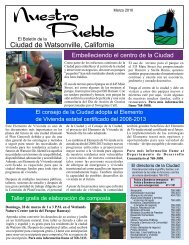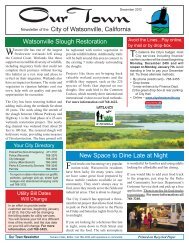Vegetation Management and Maintenance Plan - Watsonville ...
Vegetation Management and Maintenance Plan - Watsonville ...
Vegetation Management and Maintenance Plan - Watsonville ...
You also want an ePaper? Increase the reach of your titles
YUMPU automatically turns print PDFs into web optimized ePapers that Google loves.
efore the flowering season (typically spring) is usually the most effective as a means of reducing<br />
weed seeds in the project area.<br />
Within the VMMM project area, hoeing is a suitable treatment for all species where they occur as<br />
individual occurrences or small infestations. <strong>Plan</strong>ts that can re-sprout from spreading rhizomes or<br />
stems, such as cape ivy, English ivy, Kikuyu grass, <strong>and</strong> Harding grass should be removed in a<br />
controlled, careful manner such that hoeing does not encourage the species growth. Table 4<br />
identifies species suitable for hoeing. Table 5 displays the typical flowering period for the<br />
invasive weeds currently found within the VMMM project area; this table should be consulted<br />
such that hoeing is conducted prior to flowering.<br />
3.1.4 Mowing <strong>and</strong> Weed Whipping<br />
The City currently has a mowing program for the area immediately adjacent to the trails (2-foot<br />
wide strip) <strong>and</strong> other areas. This program involves seasonal mowing of herbaceous plants <strong>and</strong><br />
small shrubs (primarily coyote brush). As depicted on Table 4, many invasive weed species,<br />
including poison hemlock <strong>and</strong> bristly ox-tongue, can be controlled with a properly timed mowing<br />
program.<br />
To be an effective invasive weed control technique, a mowing or wee -whipping program needs<br />
to be timed to mow in the spring (prior to flowering <strong>and</strong> seed set – see Table 5), then again in<br />
summer <strong>and</strong>/or early fall, depending upon the rainfall year. This mowing program will adequately<br />
control most invasive weed species. This mowing program, however, is only feasible on the flat<br />
<strong>and</strong> gently sloping portions of the project area <strong>and</strong> will not be a suitable treatment for the steeper<br />
slopes that abut the sloughs.<br />
Within the VMMM project area, mowing <strong>and</strong> weed whipping is a suitable treatment for thistles<br />
(Italian thistle, slender-flowered thistle, bull thistle), bristly ox-tongue, <strong>and</strong> poison hemlock.<br />
Specifications for each of these species are listed in Table 4.<br />
The following general rules apply to weed whipping poison hemlock, bristly ox-tongue, <strong>and</strong><br />
poison hemlock:<br />
• Equipment heads should be limited to string or plastic blades. Metal blades are<br />
discourages since they may start fires <strong>and</strong> create a wind effect that limits their<br />
effectiveness. Because plastic tri-blades provide the highest level of control, plastic<br />
blades are recommended when working in areas with desirable native plants or grasses.<br />
Additionally, late in the flowering season when plants have tough fibrous stems, plastic<br />
blades are more effective than string.<br />
• The invasive weeds should be whipped as close to the ground as possible without causing<br />
erosion or damaging desirable plant species.<br />
• Table 5 provides a general timeline on the correct timing for the initial weed whipping.<br />
• Weed whipping should be timed to deplete the root reserves of invasive plants, to the<br />
maximum extent possible.<br />
• All flower heads that have gone to seed should be bagged <strong>and</strong> removed from the site. If<br />
noted for specific species (Table 4), all biomass should also be bagged <strong>and</strong> removed from<br />
the site.<br />
Thistles (Italian thistle, slender-flowered thistle, bull thistle) - The general techniques for weed<br />
whipping these three species of thistles are similar. The idea is to whip the thistles when their root<br />
reserves are depleted to the maximum extent. This limits re-growth of individual plants <strong>and</strong><br />
reduces the number <strong>and</strong> size of repeat treatments required. The timing of the initial weed<br />
<strong>Vegetation</strong> <strong>Management</strong> <strong>and</strong> <strong>Maintenance</strong> Manual<br />
Draft 17 July 27, 2007


